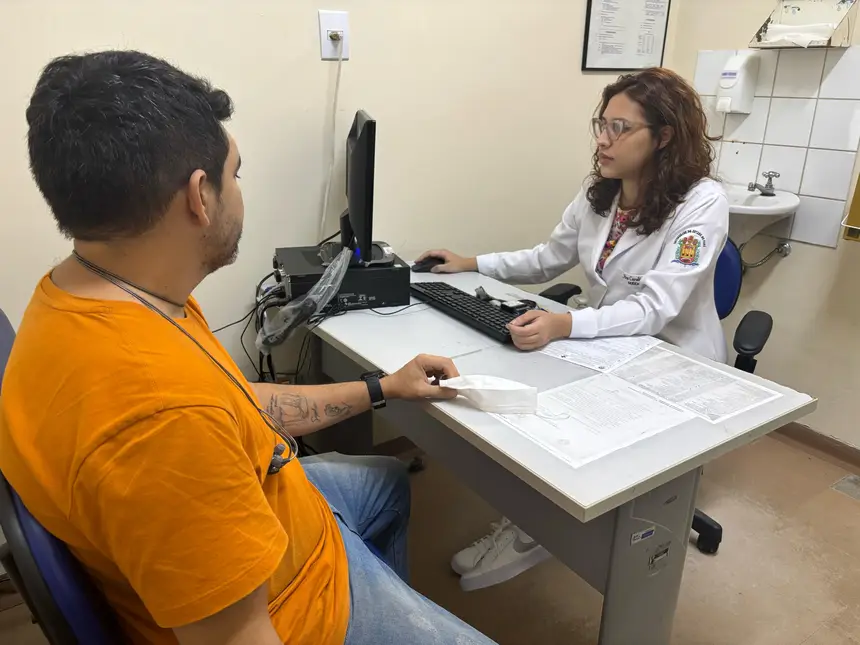Hospital warns about risk factors and early symptoms of Parkinson's Disease
Doctors point out that before tremors and muscle stiffness, subtle signs such as sleep disturbances and loss of smell may indicate the onset of the disease

In Belém, the Movement Disorders Outpatient Clinic at Hospital Ophir Loyola (HOL), a reference in the treatment of neurological diseases in the North region, receives patients diagnosed with Parkinson's referred by the Unified Health System (SUS) through the Regulation Center. Currently, the hospital offers specialized care for 100 patients with dysfunction that, although still without a cure, can be controlled with appropriate medical follow-up.
The chronic and progressive disease, according to neurologist Bruno Lopes from HOL, is caused by degeneration of nerve cells located in the substantia nigra and affects movements, other brain functions, and even behavioral aspects.
“There is no single origin; some people have a genetic predisposition that cannot be modified, but there are also environmental elements that contribute to increasing the risk,” says Dr. Bruno Lopes.
Among the most studied environmental factors, contact with pesticides—both agricultural and domestic—is pointed out as one of the main villains. “There is a very strong association in the scientific literature between exposure to pesticides, such as glyphosate and atrazine, primarily used in agriculture, and the onset of Parkinson's. But there is also a risk in using common insecticides at home, which remain in the environment for days after application,” he warns.
The specialist explains that contact can occur in various ways: skin, breathing, or ingestion of contaminated food. “Even the constant use of spray products indoors can create a cumulative effect over the years,” he explained.

The majority of patients with Parkinson's Disease are over 50 years old, an age group that represents the main risk group for neurodegenerative diseases. However, it can also affect younger people, and there are cases where individuals often need to retire early due to the progression of the illness. This situation generates various impacts, both on the patient's life and on their family members, affecting income, routine, and the well-being of everyone involved.
According to Dr. Bruno Lopes, “age is indeed the biggest risk factor. The older the patient, the greater the chance of developing this neurological dysfunction. Here at Hospital Ophir Loyola, we have a slightly younger average of patients. Many are in their 40s to 50s, and some are even under 40. This may be related to specific environmental factors, such as greater exposure to pesticides in rural areas.”
Marcelo Formento, 40 years old, a resident of the municipality of Bragança, discovered he had Parkinson's around 2016 while working as a musician. "I was a drummer, and during the soundcheck before a show, I realized I couldn't make movements that were previously automatic for me. I panicked," recalled Marcelo, who in 2018 had to step away from the band he was playing in.
The musician started treatment only in 2021 at HOL, where he attends consultations every three months and receives prescriptions for medications that help him manage his symptoms. "When I take the medication, I feel more relaxed, I can move normally, and I don't get stiff. Everything has changed, but the treatment has given me back some quality of life," he stated.
Sleep disturbances and loss of smell may be early signs
Although motor symptoms, such as tremors, slowness of movements, muscle stiffness, and difficulty walking or standing, are the most well-known, they are not necessarily the first to appear. The disease can also initially manifest through more subtle signs that are less associated with the condition. Mood changes, unexplained pain, and loss of smell are among the signs that can often go unnoticed, the so-called prodromal symptoms.
As Bruno Lopes explains, although they are not exclusive to Parkinson's, these signs may indicate that the disease is forming and may clinically manifest months or even years later. According to the specialist, awareness of environmental risks and early diagnosis are essential to improve the quality of life for patients.
“The first evidence is not specific, but in a way, it foreshadows that the disease may arise in the coming months or years,” Lopes clarifies. “One of these prodromal symptoms relates to sleep, which we call REM sleep behavior disorder. It is a phenomenon where, while sleeping, instead of the person dreaming and remaining still—which is normal—they move as if they are living the dream,” he explained.
According to the neurologist, sleep is divided into two main phases: REM sleep and non-REM sleep. During non-REM sleep—which occupies most of the night—the person does not dream and can move normally. In REM sleep, the phase where dreams occur, the body undergoes a natural paralysis that prevents physical movements, functioning as a protective mechanism.
“In people with REM sleep disorder, this paralysis does not happen. As a result, while dreaming, they end up executing the movements of the dream. If they are dreaming of running or fighting, for example, they may move violently, fall out of bed, or even hurt those nearby. The most important thing is that we have discovered that those who present this disorder have a very high chance—80 to 90%—of developing Parkinson's Disease in the next 10 years,” he warned.









